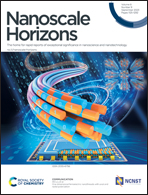A nanofluidic sensing platform based on robust and flexible graphene oxide/chitosan nanochannel membranes for glucose and urea detection†
Abstract
We present the development of a health-monitoring nanofluidic membrane utilizing biocompatible and biodegradable graphene oxide, chitosan, and graphene quantum dots. The nanoconfinement provided by graphene oxide nanolayers encapsulates chitosan molecules, allowing for their conformational changes and switchable hydrophobic–hydrophilic behavior in response to pH variations. This low-dimensional membrane operates as an array of nanofluidic channels that can release quantum dots upon pH change. The photoluminescence emission from quantum dots enables rapid and reliable optical visualization of pH changes, facilitating efficient human health monitoring. To ensure fouling prevention and enable multiple usages, we adopt a design approach that avoids direct contact between biomarkers and the nanochannels. This design strategy, coupled with good mechanical properties (Young's modulus of 5.5 ± 0.7 GPa), preserves the integrity and functionality of the sensors for repeated sensing cycles. Furthermore, leveraging the memory effect, our sensors can be reloaded with graphene quantum dots multiple times without significant loss of selectivity, achieving reusability. The wide-ranging capabilities of 2D materials and stimuli-responsive polymers empower our sustainable approach to designing low-dimensional, robust, and flexible sensing materials. This approach allows for the integration of various biorecognition elements and signal transduction modes, expanding the versatility and applications of the designed materials.

- This article is part of the themed collection: Graphene and 2D Materials in Healthcare


 Please wait while we load your content...
Please wait while we load your content...